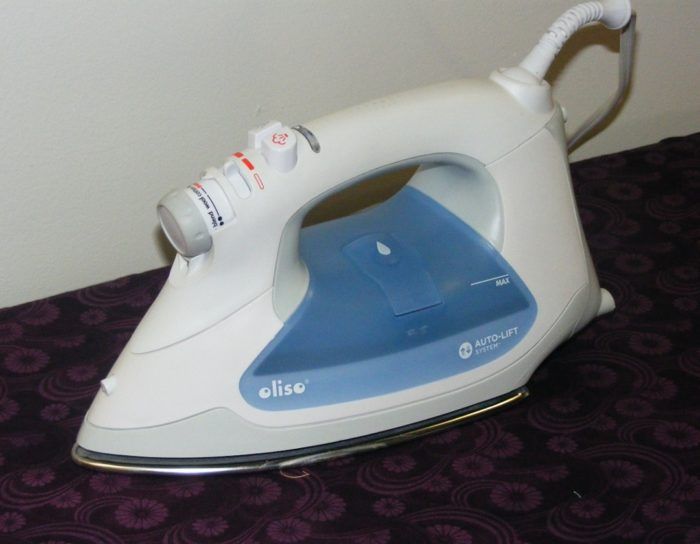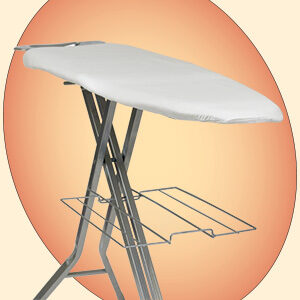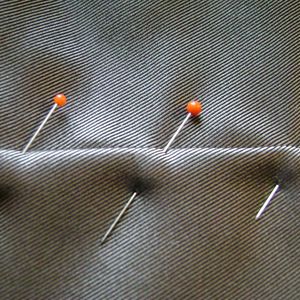
Do you iron using a plan?
When you iron a garment, do you follow precise steps?
I asked this question of several friends, and I was surprised at the different responses I received–even among those who did use a specific plan. Some always start with the top and end with the bottom (of a dress); some start with the back and move around until they return to the back, others start at the front. Some simply iron whatever hits the ironing board first, or whatever looks the most wrinkled first.
My grandmother used a specific ironing plan.
My grandmother was born in Sweden and came to the United States in 1914 when she was 16 years old as many children did at that time–leaving their families for the hopes of a better life in the US. She worked as a “domestic” in North Carolina after her arrival here. Back then domestics did a little bit of everything around the house. They cooked, cleaned, watched children, and did the ironing. There were no steam irons and no easy care, permanent-press fabrics, so ironing was a time-consuming chore, but the garments had to look good. Long after her years as a domestic, she was extremely particular with the way she ironed, and she insisted that there was a right and a wrong way.
Grandma’s ironing philosophy does work.
Grandma’s basic ironing philosophy was to press the most important part (usually the collar) twice–the very first step and the very last step. The collar had to be noticeably crisp and unwrinkled, and this double-pressing assured it would be. The steps sandwiched between the two collar pressings depended upon the garment, but they followed a general rule. The garment parts that were more prone to wrinkle while worn were ironed first (back, sleeves). She knew that whatever she ironed first would loose it’s crispness as the garment was moved on the ironing board to press other places, so she started with those areas that were going to get wriinkled anyway shortly after it was put on. Usually the garment back came after the collar for this reason. Next came the sleeves–especially long sleeves. Both of these are more easily wrinkled when one sits or bends an arm, so no worries if they loose their crispness during the ironing process. The front was ironed last (not counting the final collar pressing) because that’s the part that is most public and gives the first impression when you look at the person wearing it. As I mentioned, she followed up with another press of the collar to be sure it was perfect.
What ironing techniques do you use?
We are fortunate to have steam irons today, and the fabrics look good without as much work and fuss as at Grandma’s time, but I still use her method because I think it produces a beautifully pressed garment. Do you have a specific method that you use? Why? Please share your techniques with us.































For a shirt, I iron much like your grandmama. Collar and stand first. Then shoulders/yoke. Sleeves next with special attention to the cuffs. Then, depending on whether it is a woman's or man's shirt, I will start opposite of the button hole placket and finish with the button hole placket, ironing that slowly and pulling it taut. Occasionally, I will return to the collar if I feel it might have gotten mussed in the process.
Pants go on the end of the ironing board and ironed flat through the hips and front waist. Then seams matched and ironed on each side (four of them), with special attention to the hems/cuffs.
Ironing is rather relaxing to me. I like doing it. I especially like ironing while I'm sewing.
Seems rather . . . rigid I suppose, but ironing makes the difference in any garment.
I learned how to iron from my mom, who learned it from her mom, who was a servant in a rich household from young age. I basically iron shirts the same way described in the previous comments. I am teaching it to my daughters as well. It's an important skill to know.
I have always enjoyed ironing and used to bribe my mom when I was little if she let me stay home I would do all the ironing (7 kids there were always full baskets)for her.
I iron pretty much as mentioned. I learned from my grandmother who worked in a laundry. Pants I match seam to seam, iron inside one leg, then the other, then do the outer part, and last the waist and hip area.
My kids clothes were always ironed and I rec'd so many compliments about how neat my kids always looked. Those same people would say in exclamation "you iron?". Yes I do every day and wish I could find an iron I liked. No matter how much I pay there are all lacking.
My mother in law always inspired me to do the right thing when sewing, knitting or embroidering, but when I'm ironing I always place the ironing table with ample space everywhere because depending on the garment or the crease I move around the table and change from right to left hand. It's like I'm dancing around the table! (my MIL never moves or change hands).
I follow the steps you described before with the exception of the extra collar pressing.
I hate ironing pants, do you have any tips?
I iron a shirt with a plan the way I was taught by my father, which is sort of like grandma. First I iron the collar and stand all in one, second the cuffs then the sleeves. Third, the yoke. Fourth, front buttonhole placket(?) on the right side of the shirt. Then I iron the right side of the shirt, followed by the back, followed by the left front part of the shirt and finally pressing around the buttons. Now that's a plan that works for a shirt. Sometimes I use my Elna Press too.
My biggest tricks are ironing important clothing dry and using a tailor's ham. They ensure my button down work shirts and other items that must be super crisp are. I also use sizing as opposed to starch just to give body to lighter fabrics.
I pull items straight from the washer to my board and iron. It takes a bit more planning and time but I end up with super crisp collars for everyday wear.
First: from the washer, shirts should go 10 minutes in the dryer, enough to take the wetness out, but leave you a fairly unwrinkled perfectly damp specimen (some people hang them up to dry at this point, and later touch up where needed - it does work if you'd like to spare the shirts time in the dryer, and yourself time at the ironing board).
Next: I iron them inside out to get a large areas smooth.
Lastly: turn in right-side-out and work the sleeves, back, front, and collar (inward and frontward last). Have a mister handy to spritz and create steam on the surface fibers.
This is essentially a double pressing, but it makes for a great presentation, especially on dress shirts.
While my own two daughters rarely rarely iron for their families, I love to iron and more than that, I love to wear the types of clothing that need ironing.
My mother in law, who could teach Martha Stewart how to run a home, taught me how to iron her son's shirts. First the collar, then all tabs and flaps, cuffs, yoke, sleeves, back, fronts in that order. I have fond memories of her and at least two of her seven sisters arriving at her large colonial home on Mondays. One would jump right in at the washer and dryer, another would look for what to set up for lunch, and MIL would bring out three ironing boards and three irons into her big dining room. The sisters and she would then proceed to iron the morning away, smoke a lot of cigarettes, drink a lot of tea, gossip, and grab everything the minute it was ready from the dryer. Everything got ironed, socks, mens briefs, all linens, everything. I never had to do a lick of housework in my life so this was all very fascinating as well as totally intimidating. I learned so much from her and her sisters and will always be grateful. You have never seen such perfectly ordered dresser drawers and closets in your life as hers and that was for a family of five children.
What a totally unexpected topic! And i LOVE it!
Had never even thought about my ironing method before.
Shirts: sleeves first then right side of back yoke then total right front then back including left side of back yoke then left front and lastly, the collar and stand from the right side.
I have made many, many pair of Sandra Betzina's one-seam pants and iron from the lined-up inseam toward the outer part but no creases.
I am so lucky that my daughter has picked up the love of ironing also as when we are onboard ships on vacation, she will iron my clothes in the community laundry room.
I have had other passengers ask me to iron an article of clothing for them and I am more than glad to do so.
Edith in Dallas TEXAS
When growing up, my mother had pants stretchers that she used for work pants. I need to see if I can find them now. They almost eliminated the need to press pants.
Shirts: yoke, sleeves, right front, left front, back and then the color. Use sizing. I enjoy ironing.
I iron our pillow cases. Had a friend whose mother had a magle iron and if I had room would love one for large flat linens.
Should have said with the stretcher, long rectangle of metal that can be stretched to fit pants leg at the crease. Then hang on the line to dry.
Yes, the way your Grandma did it. And I did it as a kid when I ironed for my parents. As a seamstress, mom taught me what she said was "the correct way" to iron. And iron I did, every Saturday, in the basement. I was allowed to have my radio station on and sip a cold bottled Coke!
At that time, I ironed dad's white handkerchiefs, which were folded "just so." And dad's boxer shorts. And sheets, too. And pillowcases. And slips, which were white cotton.
This all brought back such memories. Oh yes, we use to "dampen" clothes, roll them up, put them in the fridge so they didn't dry out (or stink!) and rarely used starch.
Pat
I am the youngest of four and will be 70 in July. So I am of the era when everything got ironed. My mother had a mangle dating from the 30's and she used it as a kitchen counter. I loved the way it jerked along and the smell of freshly ironed larger items. She must have gotten tired of the regular Ironing duties as she hired a women who ironed all day Tuesday. This followed Monday which was wash day. Everything got "sprinkled" and rolled up and sat for awhile before the lady ironed. The woman would drink beer and listen to radio soaps. When I got into high school we wore white tailored shirts with blazers. I was so lazy that I would only iron the front that showed. One day "we had to" remove our jackets. Was I ever embarassed! Believe it or not I can iron and do it pretty much like "grandma." Love the concept of double ironing. I remember being a "bride" and trying to figure out how to iron my new husband's pants.
My aunt came to the rescue and taught me. Everyone needs a teacher!And I love that spray on wrinkle release, so you see I am still lazy but the stuff has gotten me out of some last minute situations and no one is wiser.
I was taught as you were except to do the little parts of a garment FIRST (collar, cuffs, yoke, lapels ....) and then do the large parts of a garment (bodice, shirt front, back, skirt, etc. ...) because fussing with the little stuff AFTER ironing the large sections of a garment inevitably creates wrinkles in the work you've already done. I also use starch on some items, not all (ie. shirts and blouses but not pants generally.)
I'm 63 and wore white oxford shirts as a teenager which had to be ironed perfectly. The method I was taught was to dampen and role the shirt/garment the night before and place in the freezer. The next day the sequence of ironing was collar, back yoke, cuffs, sleeves, back and finally front. I still use this method and enjoy the process. As a sewist my iron is my best friend which gives my garments a professional look as I iron each seam as it is sewn.
step 1: take clothing from the washer and put into the dryer.
step 2: when i hear the "ding" chime on my dryer, remove clothing.
step 3: if wrinkles are present, dampen a towel and put clothing back into the dryer.
step 4: when i hear the "ding" chime on my dryer, remove clothing. check for wrinkles. if wrinkles are still present...
step 5: pick out something else to wear.
step 1: take clothing from the washer and put into the dryer.
step 2: when i hear the "ding" chime on my dryer, remove clothing.
step 3: if wrinkles are present, dampen a towel and put clothing back into the dryer.
step 4: when i hear the "ding" chime on my dryer, remove clothing. check for wrinkles. if wrinkles are still present...
step 5: pick out something else to wear.
my momma did teach me how to iron...just not how to enjoy it...i press my seams as i sew a garment or project...i press garments that i have altered for clients before i return them...and if i have to look my very best for a wedding or funeral and such, then i will iron...i have enjoyed reading others techniques and have been inspired by them...although i'll probably stick to my old ways! :)
I also was taught to iron almost exactly as your Grandma.
Always start with collar, back, sleeves, then down each side of the front, plackets first. I usually end up doing the collar again, although I wasn't taught that, it just usually needs a touch up. My Grandma was from Scotland and I'm guessing this was the Old Country method since we were both taught the same way. I ironed ALOT as a kid. I and my brothers had to wear white shirts to school every day, and my mom wore cotton blouses frequently. I always liked ironing too, and found it relaxing.
It's so surprising how many comments this subject has garnered! Seems we all have an 'ironing' story or method.
I, too, learned from my Mother. It was my job to sprinkle clothing and roll up garmets for her in the beginning, then I got to iron Dad's handkerchiefs, and on up to shirts - the most challenging.
One of my favorite memories of my Mom is coming home from school and she would have the WGN afternoon movie on the television, with the ironing board set up in front of it, and her foot on the base of the bassinette, rocking the youngest sibling. Talk about multi-tasking!
I too have ironed in the same way for over 70 years. I also sew a lot and must iron all seams then as they are sewn into the garment. I like the Rowenta Steam iron the very best.
I learned from my Mom, who used to work as a laundress and was very particular about taking care of clothing and linens. She, and now I, iron with a plan, which is almost exactly the same plan your grandma used. It works and everything you iron looks wonderful. Next up, how do you fold clothes?!?
Mother worked in a laundry in her young years (1920s) and this is how she taught my sister and I to iron a shirt or dress:
Begin with the collar, outside first, then inside. Then right behind the neckline (or collar) which includes across the top of the shoulders from one sleeve seam across the upper back to the next sleeve seam. If this area includes an inset piece, (interfacing), it would have two layers so you would iron first the inside, then turn and iron the outside of the area. To iron the long sleeves including cuffs, iron the inside of the cuff first, then turn and iron the outside area of the cuffs. Carefully lining up the sleeves along the arm seamline, make sure there are no wrinkles. Iron one side and then the other of each sleeve arm. The front and back (or body) of the piece must be ironed being careful to get the hems and seams dry and straight. If it is a dress the skirt would be last. A circle skirt is ironed with the lay of the material so that it hangs straight. Make certain to hang each ironed item very carefully to keep it straight and without wrinkles.
Naturally, in those days, everything was starched, too. I do not use starch today, but I am now 70 and still follow all her instructions on ironing.